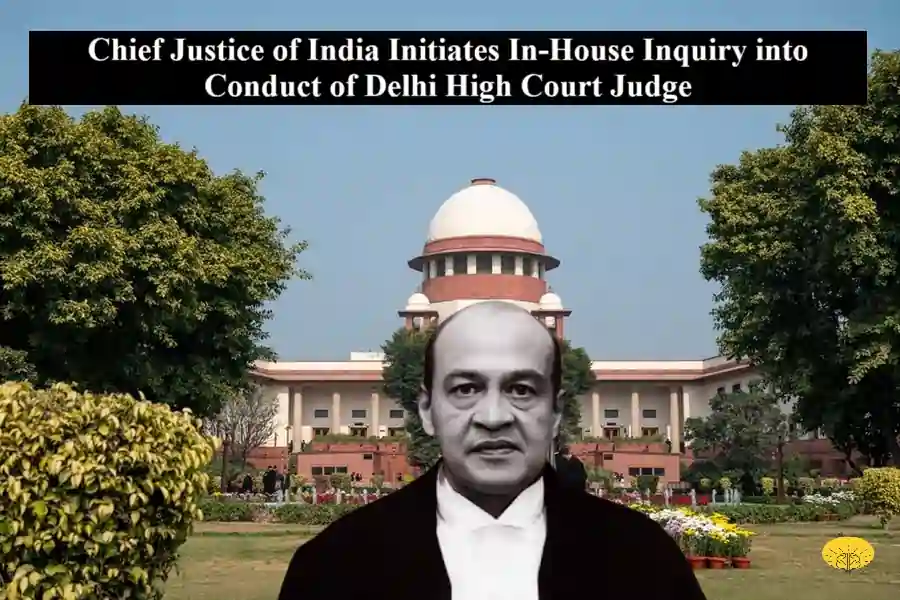New Delhi: The Chief Justice of India (CJI) has initiated an in-house inquiry into the conduct of a sitting judge of the Delhi High Court, following serious concerns regarding judicial propriety and professional ethics. This step underscores the judiciary’s commitment to upholding its integrity by addressing internal concerns through a structured review process. The in-house mechanism is a crucial tool designed to ensure accountability while preserving the independence of the judiciary.

Sanjiv Khanna (CJI) Initiates In-House Inquiry into Conduct of Delhi High Court Judge Justice Yashwant Varma
The case involves an in-house inquiry initiated by Chief Justice of India (CJI) Sanjiv Khanna into the conduct of Delhi High Court Judge Justice Yashwant Varma. The inquiry was triggered by allegations that a significant amount of cash was discovered at the judge’s official residence following a fire incident on March 14, 2025. The discovery raised concerns regarding judicial integrity and potential misconduct, prompting the Supreme Court to take action under its in-house mechanism for investigating allegations against sitting judges.
Formation of the Inquiry Committee
Following the allegations, the Chief Justice of India constituted a three-member committee to conduct a detailed investigation into the matter. The committee includes senior judges from various High Courts to ensure an impartial and independent inquiry. The members appointed to the panel are:
- Chief Justice Sheel Nagu of the Punjab & Haryana High Court,
- Chief Justice G S Sandhawalia of the Himachal Pradesh High Court, and
- Justice Anu Sivaraman of the Karnataka High Court.
This committee has been entrusted with the responsibility of examining the circumstances surrounding the discovery of cash, assessing any potential misconduct, and determining whether disciplinary actions should be recommended. The in-house inquiry is expected to adhere to the principles of natural justice, allowing the accused judge an opportunity to present his defense before any conclusions are drawn.
Understanding the In-House Inquiry Mechanism
The judiciary in India has an established in-house procedure for handling allegations of misconduct against judges that do not meet the threshold for impeachment but nonetheless raise ethical concerns. This mechanism was first introduced by the Supreme Court in response to the C. Ravichandran Iyer v. Justice A.M. Bhattacharjee (1995) case. The case emphasized the need for the judiciary to maintain its credibility by addressing allegations internally without direct political intervention.
In 2014, the Supreme Court further refined this mechanism in Additional District and Sessions Judge ‘X’ vs Registrar General, Madhya Pradesh HC. It laid down a structured seven-step process to deal with complaints against judges. Under this procedure, complaints are first reviewed by the Chief Justice of India, who assesses their credibility. If deemed serious, a three-member committee is constituted to investigate the allegations, conduct hearings, and submit a report. Based on the findings, the CJI may either take corrective measures or, in extreme cases, recommend that the judge resign or retire. If the judge refuses, further disciplinary actions, including impeachment proceedings, may be considered.
Process of Inquiry and Possible Outcomes
The in-house inquiry follows a structured process to ensure fairness and transparency. The key steps involved include:
- Filing of Complaint: Complaints against judges can be submitted to the Chief Justice of the concerned High Court, the Chief Justice of India, or the President of India (who then forwards them to the CJI).
- Preliminary Scrutiny: The Chief Justice of India examines the complaint to determine whether there is sufficient merit to warrant an investigation. In some cases, the CJI may seek a report from the Chief Justice of the respective High Court before making a decision.
- Constitution of Inquiry Committee: If the complaint appears to be valid, the CJI appoints a three-member committee comprising senior judges to investigate the allegations.
- Inquiry and Hearing: The committee conducts an in-depth examination of evidence, interviews relevant individuals, and allows the accused judge to present a defense.
- Submission of Report: After completing its investigation, the committee submits its findings to the Chief Justice of India and shares a copy with the accused judge.
- Disciplinary Action: If the inquiry finds evidence of serious misconduct, the CJI may advise the judge to voluntarily resign or take early retirement.
- Further Steps if Judge Refuses to Step Down: If the judge refuses to resign despite adverse findings, the Chief Justice of India may direct the Chief Justice of the concerned High Court to withdraw judicial work from the judge. Additionally, the matter may be escalated to the President and Prime Minister, potentially leading to impeachment proceedings.
Legal Provisions for the Removal of Judges
Under the Indian Constitution, judges of the Supreme Court and High Courts can only be removed through a rigorous impeachment process as outlined in Articles 124(4) and 217. A judge can only be removed for “proved misbehavior” or “incapacity,” and the process requires a special majority in both Houses of Parliament. The procedure is governed by the Judges Inquiry Act (1968), which sets the framework for investigating allegations against judges before initiating removal proceedings.
The process of impeachment involves multiple steps:
- A motion for removal must be signed by at least 100 Lok Sabha MPs or 50 Rajya Sabha MPs and submitted to the Speaker or Chairman.
- If accepted, a three-member judicial committee is appointed to investigate the allegations.
- If the committee finds evidence of misconduct, the matter is presented in Parliament.
- The motion must be passed by a two-thirds majority in both Houses of Parliament.
- If approved, the President of India issues an order for the judge’s removal.
This process is extremely rare in Indian judicial history, as it requires overwhelming political consensus and substantive proof of misconduct.
Historical Precedents of Judicial Inquiries in India
The Indian judiciary has witnessed several high-profile in-house inquiries in the past. Some notable cases include:
- Justice P.D. Dinakaran – The former Chief Justice of the Sikkim High Court faced allegations of land encroachment and corruption. Following an in-house inquiry, he resigned before impeachment proceedings could be completed.
- Justice Soumitra Sen – The former Calcutta High Court judge was found guilty of financial misconduct. The Rajya Sabha passed an impeachment motion against him, leading to his resignation before the Lok Sabha could act on it.
- Justice V. Ramaswami – He was the first judge against whom impeachment proceedings were initiated in independent India. Although the inquiry committee found him guilty of financial misconduct, the motion failed in Parliament.
These cases highlight the judiciary’s commitment to self-regulation, reinforcing its credibility by taking action against ethical and professional breaches.
Procedural Safeguards and Confidentiality Norms
A fundamental aspect of the in-house inquiry process is confidentiality. The proceedings are not made public unless they escalate to an impeachment stage. This ensures that judges facing unverified or baseless allegations are not subjected to unwarranted public scrutiny.
The judge under investigation is provided a fair opportunity to respond to all allegations, present supporting evidence, and seek legal representation. The inquiry panel follows the principles of natural justice, ensuring that all deliberations are free from bias and undue influence. This system helps balance transparency with the need to protect judicial independence.
Potential Outcomes and Their Implications
The in-house inquiry can result in several possible outcomes depending on the findings:
- No Misconduct Found – If the judge is exonerated, the matter is closed without any public disclosure.
- Minor Ethical Violations – If minor infractions are found, the committee may issue a private censure or advisory notice.
- Serious Misconduct – If the judge is found guilty of major ethical violations, the committee may recommend resignation or removal.
- Impeachment Proceedings – In cases of grave misconduct, the committee’s findings may be forwarded to Parliament for impeachment under constitutional provisions.
If impeachment is recommended, the process involves multiple stages:
- Initiation of Motion – A motion for removal is introduced in either House of Parliament and must be signed by 100 MPs in the Lok Sabha or 50 MPs in the Rajya Sabha.
- Investigation by a Committee – A three-member judicial committee is constituted to investigate the charges.
- Parliamentary Vote – If the committee finds the judge guilty, both Houses must pass the motion with a two-thirds majority.
- Presidential Approval – Upon successful passage, the President issues an order for the judge’s removal.
Impeachment is an extremely rare and complex process, making the in-house inquiry a more viable means of maintaining judicial discipline.
Impact on the Judiciary and Public Confidence
The initiation of this inquiry reinforces the judiciary’s commitment to accountability and ethical governance. Given the increasing scrutiny on institutional integrity, such mechanisms serve as essential safeguards against judicial misconduct.
While the independence of the judiciary must be preserved, judges are also expected to uphold the highest ethical standards. The in-house inquiry process ensures that any deviation from these standards is dealt with internally, maintaining public trust in the justice system.
This case also brings to the forefront discussions on judicial transparency and oversight. While complete transparency in disciplinary actions could compromise judicial independence, a balanced approach ensures that errant judges are held accountable without undue political or public pressure.
Conclusion
The Chief Justice of India’s decision to initiate an in-house inquiry into the conduct of a Delhi High Court judge is a significant development in judicial oversight. This inquiry follows a structured legal process that upholds the judiciary’s credibility while ensuring due process for the judge under scrutiny.
Regardless of the final outcome, this case underscores the judiciary’s ongoing efforts to uphold ethical standards, preserve institutional integrity, and maintain public confidence in the justice system. By implementing a rigorous internal review process, the Indian judiciary continues to demonstrate its commitment to fairness, accountability, and the rule of law.
FAQs
1. What led to the in-house inquiry against Justice Yashwant Varma?
The inquiry was initiated after a significant amount of cash was discovered at Justice Yashwant Varma’s official residence following a fire incident on March 14, 2025. This raised concerns about potential misconduct, prompting Chief Justice of India (CJI) Sanjiv Khanna to order an internal investigation.
2. Who is conducting the inquiry, and what is the process?
A three-member committee has been constituted to investigate the allegations. The members are:
- Chief Justice Sheel Nagu (Punjab & Haryana High Court)
- Chief Justice G S Sandhawalia (Himachal Pradesh High Court)
- Justice Anu Sivaraman (Karnataka High Court)
The inquiry follows a structured process, including preliminary review, evidence examination, and hearings, after which a report will be submitted to the Chief Justice of India.
3. What actions can be taken against the judge if misconduct is proven?
If the inquiry finds evidence of misconduct, the CJI may advise Justice Varma to resign or take early retirement. If he refuses, the CJI can direct the High Court Chief Justice to withdraw his judicial work and may escalate the matter to the President and Prime Minister for possible impeachment proceedings.
4. How does this inquiry differ from the impeachment process?
The in-house inquiry is an internal judicial mechanism to handle misconduct allegations without direct political intervention. Impeachment, on the other hand, is a constitutional process under Articles 124(4) and 217, requiring a two-thirds majority in both Houses of Parliament to remove a judge. The current inquiry may recommend impeachment if serious misconduct is found.
5. Why is this case significant for India’s judiciary?
This case is a rare instance where the judiciary’s internal disciplinary mechanism is being tested. It highlights the judiciary’s commitment to maintaining integrity and accountability while reinforcing public trust in the judicial system. The outcome could set a precedent for handling similar cases in the future.

